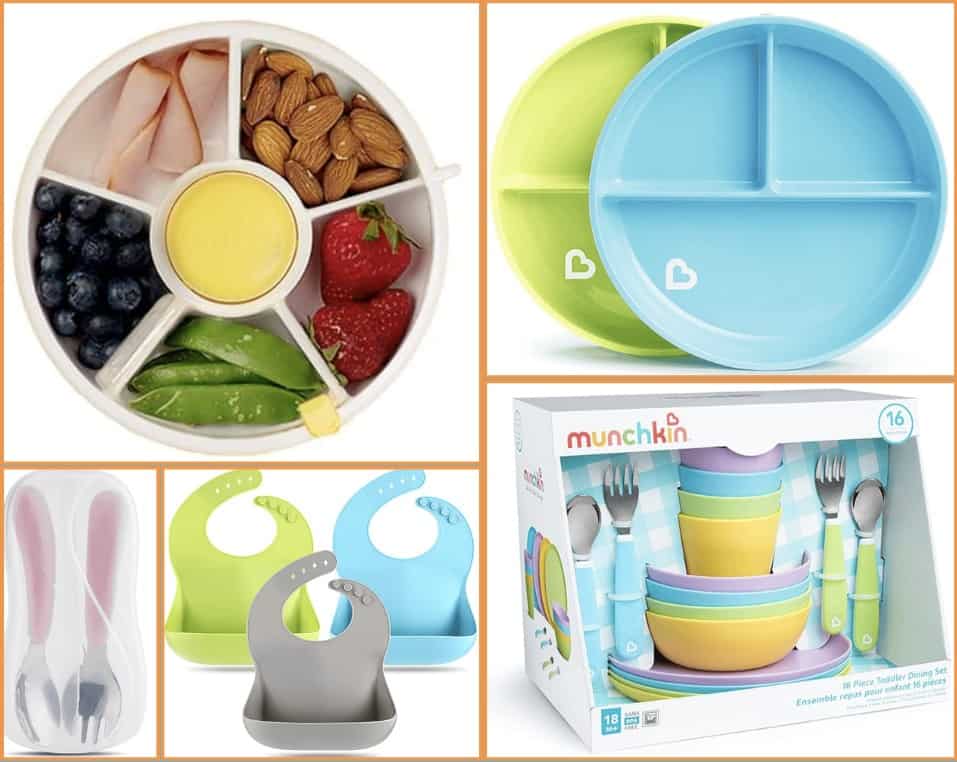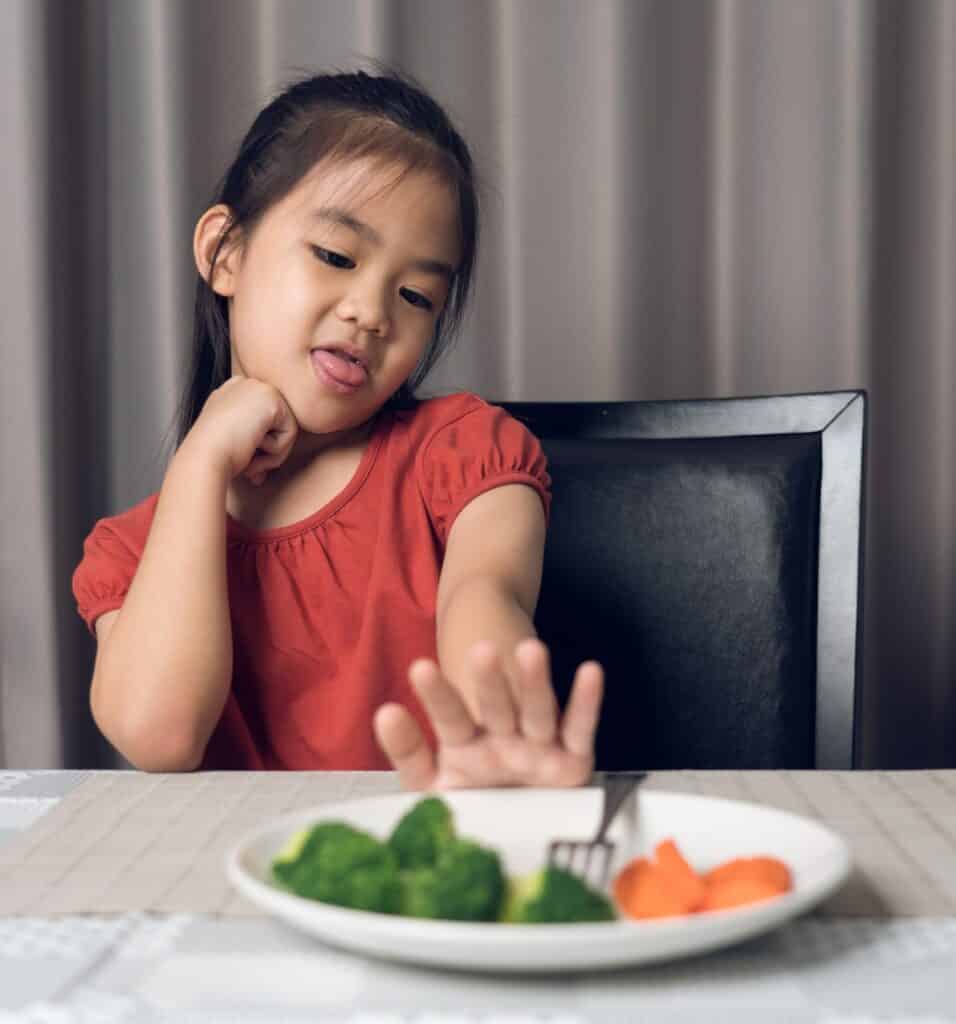If your toddler won’t eat, refuses everything on their plate, being picky eater or is only drinking milk and eating snacks, you’re not alone.
I’ve been there.
My 2-year-old won’t eat anything but snacks. If she didn’t recognize something on her plate, it went straight to the floor. Then she’d scream for milk and refuse everything else.
Because she gets hangry fast, I often gave her snacks between meals just to keep the meltdowns at bay. Sometimes, I’d scramble to make her something else just to ensure she ate something.
🚨 Big mistake.
It took me months of trial and error to find the ONE strategy that actually works—a science-backed approach that stopped the food refusals and mealtime battles.
If you’re also wondering “when to worry about picky eating”, read on.
Why toddlers won’t eat? What do we do wrong?
We parents have good intentions, but often we accidentally make picky eating worse. Here are common mistakes when toddler won’t eat:
1. Becoming a Short-Order Cook (Making different meal)
YYou serve a healthy dinner. Toddler says “NO!” and wants mac and cheese. So, you whip up a separate toddler-approved meal.
🚨 Why it backfires? Research shows that making separate meals reinforces picky eating.
- A systematic review in the International Journal of Behavioral Nutrition and Physical Activity discusses how offering alternatives can reinforce picky eating behaviors, as kids learn that refusing food gets them something better.
2. Letting Them Eat Only What They Want from the Plate
Some parents take a relaxed approach: “Eat whatever you want from the plate, and that’s it.”
🚨 Why it’s tricky: While this respects hunger cues, it often leads to toddlers only eating carbs (pasta, bread, fruit), making meals nutritionally unbalanced.
- Studies on appetite regulation (Birch et al., 2017) show that kids naturally regulate hunger, but repeated exposure to new foods is key for expanding food preferences.
- “Prevalence of picky eaters among infants and toddlers and their caregivers’ decisions about offering a new food” (Betty R. et all, 2024) found that it takes up to 15 exposures before toddlers accept a new food hence caregivers need to offer food more than 3-4 times as they usually do.
3. Allowing Grazing Throughout the Day
You let your toddler have crackers, puffs, or milk all day, hoping they’ll at least get some nutrition.
🚨 Why it’s a trap: TToo many snacks = zero appetite for meals. And guess what? Picky eating gets even worse.
- Snacking constantly messes with their natural hunger signals. Feeding Matters explains how grazing can reduce appetite and affect nutrition. Feeding Matters – Is Grazing Impacting Your Child’s Nutrition?
The One Secret That Actually Works: The Safe Food Strategy
The ONLY proven way to stop picky eating is to offer one “safe food” alongside new foods at every meal.
What Is a “Safe Food”?
A safe food is something your child already likes and feels comfortable eating. Examples that I use include:
✔ A piece of toast
✔ A bowl of plain yogurt
✔ Cheese slices
✔ A side of fruit
My daughter also likes mushrooms, ravioli or dumplings, avocado, cucumber, peanut butter, mini naan, low fat mozzarella cheese. So I make sure o have one of these always alongside with the meal.
Why This Works (science says so!)
- No Hunger Meltdowns, No Picky Eating Reinforcement: Offering a safe food means they won’t go hungry without teaching them that refusing food gets them special treatment. Rutgers NJAES highlights the benefit of familiar foods. Rutgers NJAES – Picky Eating Strategies
- Takes the Pressure Off: No more forcing bites! When there’s a safe food, there’s less pressure to try new things. And guess what? Less pressure actually makes kids more likely to try new foods! Child Feeding Guide explains how to avoid pressure at mealtimes
- It’s Already There! The safe food is part of the meal, not a special “reward” for refusing other foods. It reinforces “this is what we’re eating.”
How to use the Safe Food method at every meal
✅ Step 1: Safe Food on Every Plate
Every meal should have:
🍗 A protein (chicken, eggs, beans)
🥦 A vegetable (carrots, peas, cucumbers)
🍞 One safe food (toast, yogurt, cheese)
Need ideas? Check out top 50 foods to start with and other best foods for starting solids or my go-to 20 nutritious breakfast meals
I found that this strategy made my daughter more relax to try other foods on her plate.
✅ Step 2: No pressure
If they only eat the safe food? It’s okay! Seriously. No pressure, no begging, no airplane spoons.
Research in Pediatrics shows that forcing food creates stress and doesn’t help in the long run. Child Feeding Guide has great tips on responsive feeding. Child Feeding Guide – Responsive Feeding
Instead of “Just one more bite!” try: “You can eat if you’re hungry. If not, we’ll eat again later.”
✅ Step 3: Keep the Routine Consistent
If they refuse the meal, there are no snacks or extra milk right away. The next eating opportunity is at the next meal or snack time.
- Studies show that a predictable meal schedule improves food acceptance (Journal of Pediatric Psychology, 2021).
- A study (Powell et all, 2016) suggests that it may be important for parents to strike a balance between structured mealtimes, where the family eats together and distractions are minimal, alongside allowing children some autonomy in terms of food choice and intake.
✅ Step 4: Offer choice (when possible)
Studies (Powell et all, 2016) shown that allowing kids some autonomy in terms of food choice and intake resulted in less fussy and peaky eaters.
I personally apply these technique in the morning for breakfast before I start making it. I would give my daughter two choices “what do you want to eat: eggs or oatmeal?” This will put her incharged and it’s less likely for her to refuse the meal afterwards.
What If My Toddler Only Wants Milk?
🚨 My 2-year-old won’t eat, only drinks milk—what should I do?
Milk is good, but too much? Not so much.
- Limit milk to 16-24 oz a day. Too much milk can actually lead to iron problems and make them more picky! Mott and Nationwide Children’s Hospitals warn about excessive milk intake. University of Michigan Health – Iron Deficiency in Children Nationwide Children’s – Iron Deficiency Anemia
- Milk with meals, not all day. All-day milk drinking kills their appetite for real food.
- Food first, then milk (if they still want it). If they’re hungry, offer the meal, not milk. This helps them learn that meals are for hunger, not just milk. I make sure my daughter gets the milk after the meal, and only when she asks for it. And most of the time she forgets about it because she is full.
My “Aha!” moment
I used to stress SO much when my daughter refused meals. But the “safe food” strategy changed everything.
She knows what to expect. No more mealtime surprises. Seeing a familiar food calms her down, even if she’s unsure about the rest. And guess what? Slowly but surely, she’s trying new things! No pressure, no tears. And those “new” foods sometimes become her new safe foods!
The secret to less picky eating? Safe food, calm parents, and consistency.
This strategy is perfect for:
- Toddlers who refuse meals
- Worried parents of picky eaters
- Getting healthy food into fussy kids
- Toddlers who live on snacks and milk
Would you try this method? Let me know how it goes in the comments!
See best feeding products that your bay and toddler would love.


